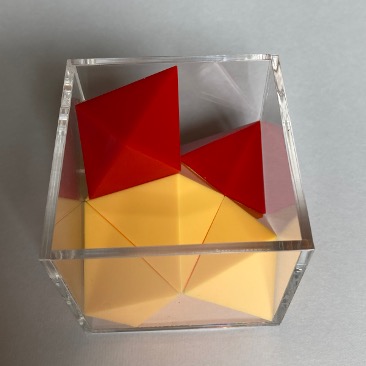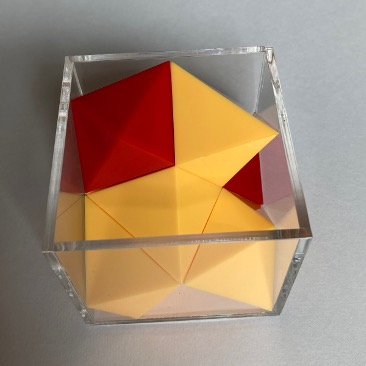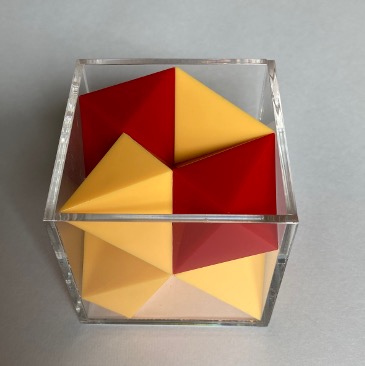ピースの間に隙間のない入れ方
ステップ1
まず H を入れましょう。
真ん中にスペースをあけるように入れます。

ステップ2
隣に T を入れましょう。
Hと同じ細い二等辺三角形の面で接するように入れます。

ステップ3
反対側の隣にも T を入れましょう。

ステップ4
下段の残りにも T を入れます。今度は、隣のピースとは辺で接します。
大きな正三角形の2辺で接するようにしましょう。
真ん中に窪みができました。この窪みの形は T の尖った頂点の形そのものです。

ステップ5

ステップ6
お互いに接する面の形を合わせるように入れていきましょう。

ステップ7
面の形を合わせるように入れていきます。

ステップ8
面の形を合わせるように入れていきます。

ステップ9
9個のピースが全て収まりました。完成です。

ステップ1 で他の入れ方から始めても,同様に解くことができます。
しかし,ピースの間に隙間のない入れ方はどれも,箱を回転すると同じ入れ方になります。
ピースの間に隙間のある入れ方
ピースの間に隙間のある入れ方はたくさんありますが,今まで見つかった方法はどれも, ステップ 5 のように真ん中に T を入れるものです。
ピースの間に隙間のある解で、箱の真ん中に T を入れるものは、512通りあります。(箱の横回転で重なるものは同一視し、鏡像を同一視しない場合)
鏡像となる入れ方を同一視すると、276通りあります。
さらに、箱の3次元的な回転で同じものも同一視すると、52個あります。
この計算を行った「Pythonプログラム」および、その「google colab」へのリンクです。
512が2ベキの数であることに意味はないと思われますが、神秘性を感じます。
テセレーションデザイン協会の荒木義明さんが、136通り(276通りの中で真ん中の T を固定したもの)の図を作ってくれました。